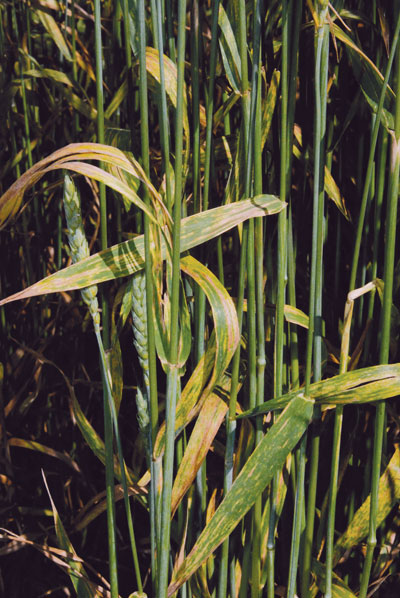
Features
Agronomy
Soybeans
Tank-mix cereal herbicides and fungicides with caution
The idea sounds good: tank-mixing a fungicide and herbicide to do a one-shot weed and disease control application. The trouble is, says Kelly Turkington, research scientist at Agriculture and Agri-Food Canada at Lacombe, Alberta, the application timings when the most benefit can be derived from the products do not often match. The timing is either too early for disease control, or too late for weed control. “You need to apply the fungicide to the leaves you want to protect, but the herbicide needs to be applied much earlier to help reduce weed competition,” he explains.
May 25, 2010 By Bruce Barker
The idea sounds good: tank-mixing a fungicide and herbicide to do a one-shot weed and disease control application. The trouble is, says Kelly Turkington, research scientist at Agriculture and Agri-Food Canada at Lacombe, Alberta, the application timings when the most benefit can be derived from the products do not often match. The timing is either too early for disease control, or too late for weed control. “You need to apply the fungicide to the leaves you want to protect, but the herbicide needs to be applied much earlier to help reduce weed competition,” he explains.

|
|
| The goal of fungicide application should be to protect the upper canopy leaves. (Photo by Bruce Barker)
|
To help understand the reasons why the timing does not match up in cereals, Turkington points to several research studies done in the past. For herbicide application, the optimum timing is well known; early weed control, usually around the two- to three-leaf stage, provides the best yield protection. The longer a grower waits for herbicide application, the more yield he will lose.
For disease control, the main role of fungicides is to protect healthy plant tissue. Turkington explains that a fungicide does not rescue a crop that is already heavily diseased. The reason is that almost all the products have very little eradicative activity with limited activity on well-established disease lesions. Essentially, a fungicide will not fix damaged tissue.
Most foliar fungicides in Canada are systemic. The active ingredient will penetrate into the leaf tissue and can move within the leaf tissue, typically with the water transpiration stream. However, most of these systemic fungicides are only locally systemic with very little movement, so they only move within the targeted leaf and do not move to new leaves. “In general, fungicides will not move from one leaf to a new leaf. If you are not going to provide protection to the new leaf with another fungicide application, disease will develop there,” says Turkington. “You want to protect the leaves that are the most critical for yield and quality.”
Protect leaves that contribute to yield
For most cereal leaf diseases, the most important factor in yield loss is the destruction of photosynthetic leaf area that contributes to grain development and filling. Turkington explains that the top three leaves in barley and the top two leaves in wheat contribute the most to grain development and kernel filling. As a result, “Protect the upper leaves,” has become the rallying cry for disease control, and the reason that fungicide applications in cereals are targeted around flag leaf emergence. “We advocate delaying fungicide until these critical leaves are emerging. The target should be those upper canopy leaves in the barley and wheat crops,” explains Turkington.
Turkington cites research at AAFC in 1999 and 2000 when the researchers looked at several different application rates and timing with Tilt fungicide for control of net blotch in barley. He compared a no fungicide check to a full rate of Tilt at the two- to three-leaf stage, a full rate at the flag leaf stage, a split one-half rate at the two- to three-leaf stage with a second one-half rate at flag leaf stage, a full rate at head emergence, and split one-half rate at the two- to three-leaf stage followed with one-half rate at head emergence. “The most consistent reduction in leaf disease was when Tilt treatments included the full rate application at the flag leaf stage or heading,” says Turkington. “Where we put Tilt on at the two- to three-leaf stage, we didn’t see the same level of control of net blotch, and didn’t see the same increase in yield, kernel weight or plumpness as we did with the flag leaf stage applications.”
Research at AAFC Melfort provided similar results in wheat, where research scientist Randy Kutcher evaluated Tilt at the four- to five-leaf stage for tan spot management. He did not find any significant difference in the level of disease whether the fungicide was sprayed or the crop was left untreated, indicating that the early application did not change disease severity. There were not any differences in yield or quality, either.
Turkington cautions that multiple or split applications can also increase the selection for fungicide resistance. “The more frequently you put on a fungicide, such as an application at the early leaf stage plus an application at the flag leaf stage, the greater the potential to select for fungicide resistance in the pathogens that you are trying to control,” he explains.
For optimum leaf disease management, Turkington says that producers should use an integrated approach with a combination of strategies, including growing resistant varieties, rotating crops, scouting to assess disease severity and risk, and applying fungicides at the appropriate leaf stage. And that means avoiding the temptation to tank mix a fungicide with a herbicide.